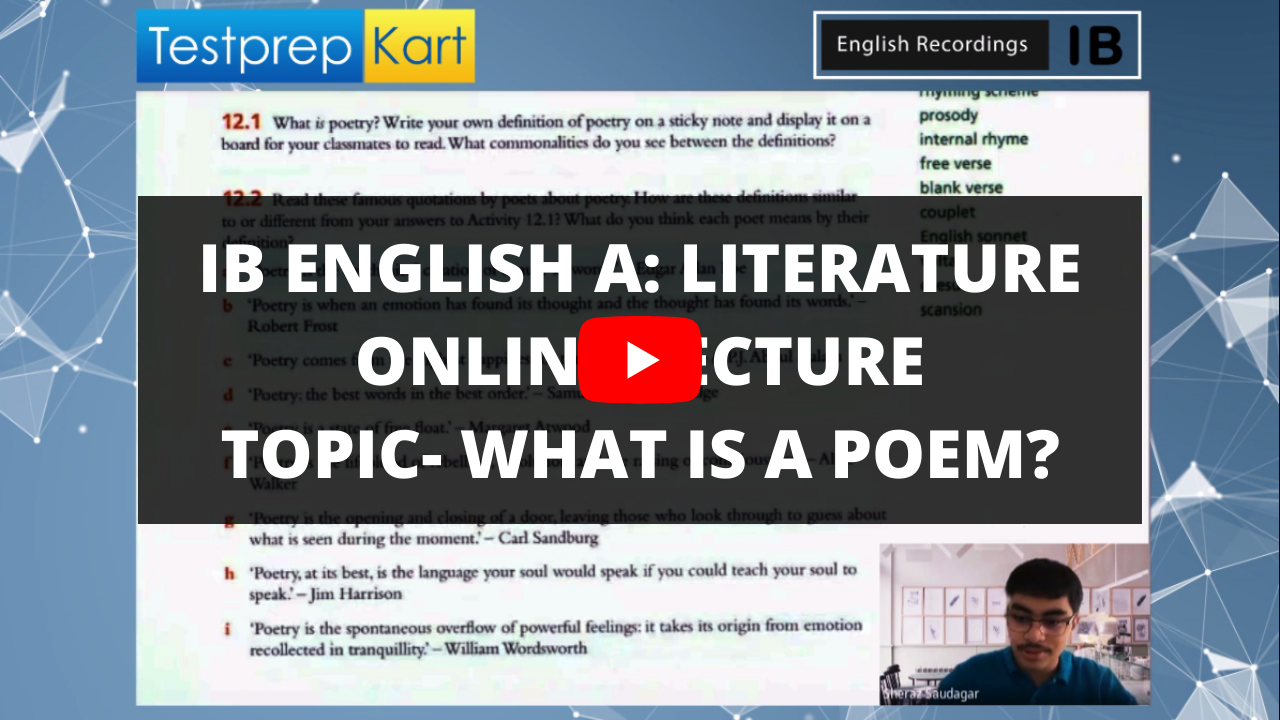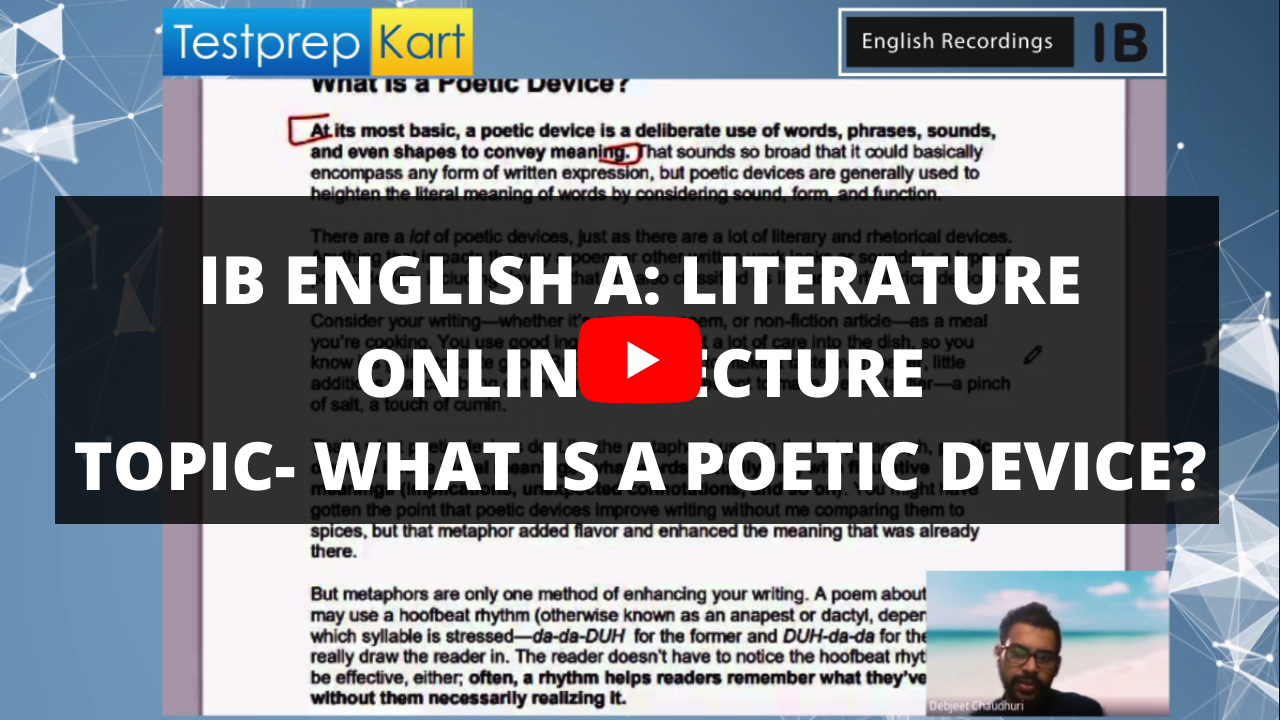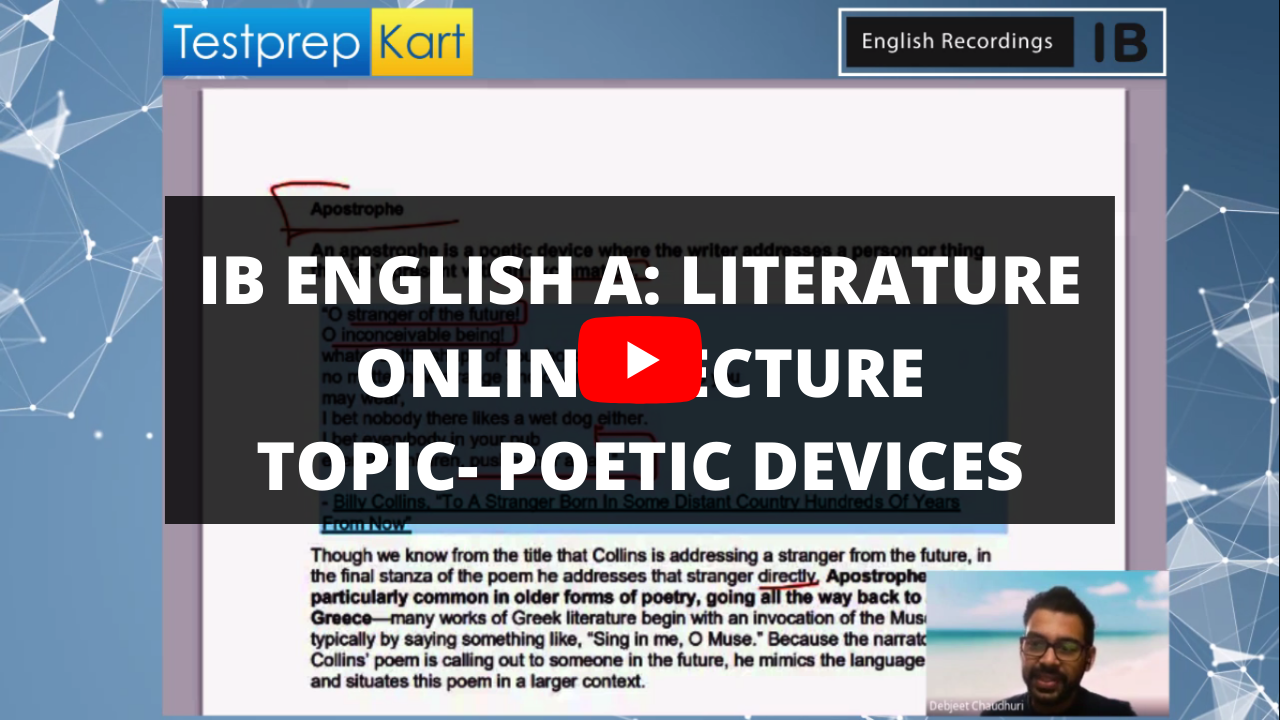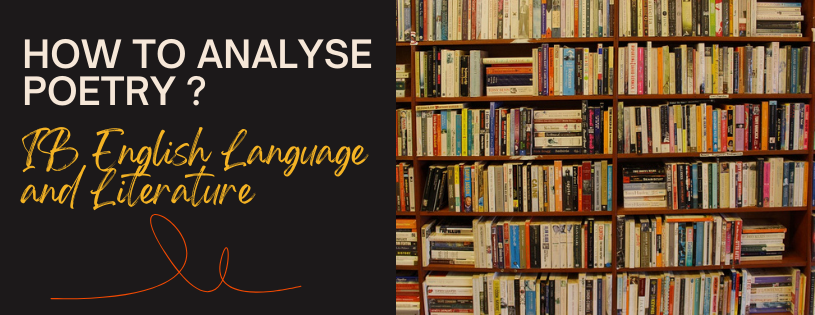How do you Analyse a Poem in IB English Literature?
How can I understand poems easily? How do you get a 7 in English Paper 1? These questions will be answered in this guide for IB English Poetry (Paper 1 External Examination).
Analysing poetry is an intricate process and very crucial for the first paper of IB English A Literature. For analysis and commentary, students are provided with either poetry or prose. It’s not really about structure or a specific format (unlike the paper 2 Essay) but about interpreting the text correctly.

Get Free IB Trial Session
Steps on how to analyse a poem
-
Before anything, read the poem properly. Read the title and try to understand what the poem is talking about.
-
Highlight all the verses, words and poetic devices that you deem are important.
-
Think about the theme of the poem or the central idea. The best way to understand it is by reading the first and the last verses of the poem. It will generate curiosity and questions. You will then automatically find answers by reading the poem completely.
You can use this approach for ib unseen poetry in paper 1 as well !

Use PQAL structure
How to analyse the evidence? How to write commentary? These questions will be answered using this method. We need to convey the deeper meaning behind the poem. This will help you nail the IB Literature paper 1.
PQAL stands for Point, Quote, Analysis, Link
Point
It talks about how you introduce the quote and show its significance while writing the commentary. Students need to ask themselves, How does this quote associate to the point of your paragraph?
Quote
After finding out the point, try to find the most logical and appropriate quote that will provide evidence for the point. It need not be too comprehensive, it can be a few words. Make sure you place it in a sentence, rather than leaving it alone.
Analysis
This is the part where we criticize the quote and break it down. For this step, try to use literary devices such as metaphors, imagery, alliteration etc. Make sure you use the proper terminology. You can find all the important literary terms down below.
Link
This step is about linking back to the central idea/theme of the paragraph.
What is a Poetic Device?

Poetic devices are a form of literary devices that are used in Poems. They are the components which make a poem, A POEM ! They help in enhancing and amplifying the mood of the material. Along with the poetic devices we have ib poetry analysis example of each.
Get Free IB Trial Session Download IB English eBook
What are the types of Poetic devices?

Get Free IB Trial Session
Following are the Poetic Devices that you should know!
Allegory
An allegory is used when a story or a poem are deciphered to have a secondary meaning.
Example
“The Lion, the witch and the Wardrobe” by C.S Lewis
“Animal Farm” by George Orwell
“Young Goodman Brown” by Hawthrone
Alliteration
Alliteration is the repetition of a sound or letter at the beginning of multiple words.
Example
"Fair is Foul, and Foul is Fair:
Hover through the Frog and Filthy air"
-Macbeth by William Shakespeare
Allusion
It is an indirect reference
Example
"I wish I could just click my heels."
-The Wizard of Oz
Apostrophe
It is used when the writer/author addresses the person who is not present with an exclamation.
Example
“Oh nature, thou art my goddess”
Assonance
Assonance is the repetition of identical or similar vowel sounds in a series of words, phrases or syllables
Example
“Clap your hands and stamp your feet.”
“Try to light the fire.”

Blank Verse
Blank verse is a verse which does not have any rhyme and uses iambic pentameter.
Example
“But soft! What light through yonder window breaks? It is the east, and Juliet is the sen!”
-Romeo and Juliet by William Shakespeare
Consonance
It is when repetitive sounds are produced within a sentence or a phrase.
Example
“Whose woods are these are I Think I know.
His House is in the village though;.”
Couplets
A simple two line poem that rhymes is a couplet. Each line shall consist of the same number of syllables. They are often silly.
Example
“I have the measles and the mumps,
A gash, a rash and purple bumps”
Enjambment
It is the practice of running lines of poetry from one to the next without using any kind of punctuation to indicate a stop.
Example
"I’m feeling rather sleepy, but
I really don’t know why. I guess it
Is the way the day has spun
Out of control"
Imagery
It is used to appeal to the 5 senses in order to help readers imagine exactly what is being described.
Example
“Two Roads diverged in a yellow wood,
And sorry I could not travel both
And be one traveler, long I stood
And looked down one as far I could
To where is bent in the undergrowth;”
-The Road not Taken
Irony
It is when a person delivering a statement is completely opposite to what they mean or what the reality of the situation is.
Example
Trusting no man as his friend, he could not recognize his enemy when the latter actually appeared”
-The Sacred Letter
Metaphor
A metaphor compares one item with another by saying that it is the other item.
Example
“I water it in fears, night and morning with my tears. I sunned it with smile”
-A Poison Tree
Meter
Traditional forms of verse use established rhythmic patterns called meters.
Example
"I do not like green eggs and hams,
I do not like them, Sam-I-Am"
Ode
It is an elaborate structured poem praising or glorifying an event or an event or individual.
Example
Oh coffee maker,
As brewing your steam rises
And wafts through the air,
So i rise from fitful slumber
Onomatopoeia
Words which represent or imitates natural sounds
Example
“Bright streaks whiz through the sky.
Thunk! Whoosh!
Brightly coloured explosions
Sizzles and pop, pop, pop.”
Fireworks

Oxymoron
The side by side placement of words that are contradictory in meaning
Example
“I find no peace, and all my war is done
I fear and hope, I burn and freeze like ice,
I flee above the wind, yet I cannot rise”
Personification
Personification is used when human qualities, feelings are given to a non living thing or inanimate objects. It is used to show that an item or thing has performed an action when in reality it has not/could not.
Example
“The wind is whistling
The clouds are crying
The trees are dancing
The sun left us
Because the winter is visiting us”
Winter (Janna ghossein)
Pun
Words that are alike or nearly alike in sound but different in meaning; a play of words.
Example
“If you were an angle, you would be acute”
Love Triangle (Lang leav)
Repetition
Repeating a word or words to enhance effect
Example
“Nobody
No, Nobody
Can make it out here alone.
Alone, all alone
Nobody, but nobody
Can make it out here alone”
Rhetorical Question
Questions used for effects that are not be answered. This usually draws the audience’s attention into a specific area.
Example
“I wonder if they like being raindrops?
I suppose they do
They always have friends around them
They never travel alone
Some people save them to wash their hair
They make trees grow”
Raindrop feelings (Tierra Jones)
Rhyme Scheme
A rhyming pattern that is created at the end of lines of poetry.
Example
Mary had a lamb, (A)
Its fleece as white as snow (B)
And everywhere that Mary went, (C)
The lamb was sure to go (B)
Rhythm
Rhythm is a flow of the beat in a poem and gives poetry a musical feel.
Example
"Because I could not stop for death,
He kindly stopped for me;
The carriage held but just for ourselves
And immortality"
Simile
A comparison of two things by using the words “like” or “as”
Example
“Mary had a lamb,
Its fleece as white as snow
And everywhere that Mary went,
The lamb was sure to go”
Sonnet
A poem of fourteen lines using any of a number of formal rhyme schemes, which has an iambic pentameter meter.
Example
“Death be not proud.” —John Donne
“Shall I compare thee to a summer’s day?” —William Shakespeare
Stanzas
A group of lines that helps to break up and organise how the poem appears
Get Free IB Trial Session Download IB English eBook

USEFUL BLOGS
1. IB English Literature Preparation Guide
2. How to write Essay for IB English A Literature?


Post a Comment